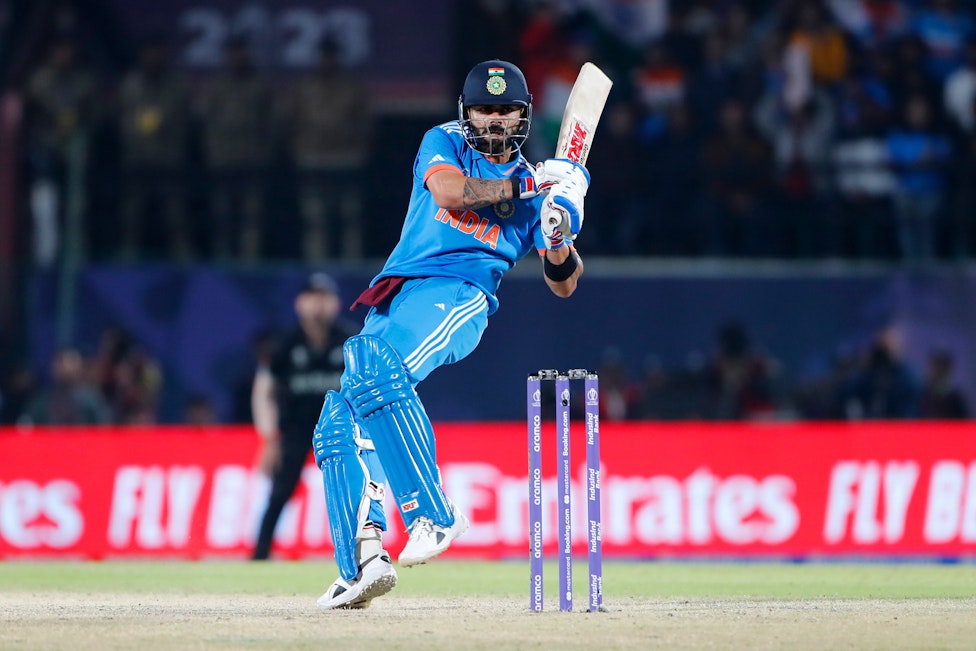 FEATURES
FEATURESTwo matches, two different kind of innings.
Only three days ago, Virat Kohli had a sailing start against Bangladesh. Thanks to the pacers dishing out free hits, the right-hander took three deliveries to get into double figures. In Dharamsala on Sunday night (October 22), it took him 18 balls to get there. While it was still a perfectly normal start, the conditions were different. The target was only 17 runs more, but in New Zealand, Kohli was up against the most efficient attack of this World Cup.
India had lost both their openers in a space of five runs. There was Mitchell Santner, the tournament’s best spinner so far, bowling from one end. You are living under a rock if you are not aware of Kohli’s travails against left-arm orthodox spin. In ODIs since 2022, he averages 20.5 against slow left-armers. He has been dismissed eight times by them and has a modest strike rate of 71.5. Against every other bowling type, his strike rate is above 90.
It was not a minefield, but India needed Kohli. He is exactly the kind of player teams need in a tricky chase in a World Cup. Someone who can absorb the pressure.
When Suryakumar Yadav was run out, with Kohli also playing a part in the mix-up, India were still 83 away from the target. Ravindra Jadeja was going to bat for the first time in the tournament. And then Jasprit Bumrah at eight. New Zealand were threatening to come back in the game, but Kohli’s wicket was indispensable.
The former Indian captain knew that. He first soaked in the pressure and then made his way through.
****
Kohli was 28 off 47 balls at the end of the 28th over. The required run rate had increased from 4.9 ten overs ago to 5.6. Rachin Ravindra, another left-arm spinner, had bowled eight consecutive dots to him. In Lockie Ferguson, Trent Boult, and Matt Henry, New Zealand always had a wicket-taking option at the other end.
He soaked in the pressure at one end and made his way through at the other. The 34-year-old played out his negative match-up, scoring only 29 runs from the 50 balls he faced from Santner and Ravindra in the innings. He attacked only 26% of their deliveries.
At the other end, the Delhi batter made up for his chinks against spin with his supremacy versus pace.
Overall, The former India skipper batted at a strike rate of 67.3 against spin and 118.4 versus the fast bowlers. He had started the innings with a sumptuous backfoot punch for four against Ferguson. Later, a flat six off a pull shot against Boult killed the game for the host nation.
It was a masterclass from Kohli of a different kind. Normally, you associate him with dominating bowlers through and through, dictating things in his own manner. But of late, since 2022, he has developed shortcomings against left-arm finger spin. Acknowledging that, Kohli kept himself in check. There was no turn in the pitch, allowing him to minimize the risks.
Despite a string of dots in between and Glenn Phillips at covers blocking various attempts to rotate strike, Kohli never seemed hurried. The asking rate never went beyond 5.6 and he was still dictating the chase without making the Kiwis feel like it. You can sense it in his control percentage - 93.1%. It is the highest for him in an innings this World Cup.
Kohli was in free flow against Bangladesh. But twice when he was imperative to the chase, he has denied himself.
****
In terms of marrying fluency with consequence, this was Kohli’s best innings of the tournament thus far. The ‘chase master’ has assessed the conditions and match the situation perfectly to plan his run chases.
India have now won each of their five matches in this World Cup, placed at the top of the points table. The senior players have stepped up. Bumrah has pouched 11 wickets at an economy of 3.1. Rohit Sharma has made things easier for the middle order with a blitzkrieg up top. Kohli has brought his monk-like calmness in the run chases. It is like Rohit has become more aggressive up top as a trade-off with Kohli to steer the ship in the middle overs.
Chasing in all five games, Kohli has scored three fifties and one hundred. Moving forward, as batting may get trickier in the second half of the tournament, Kohli can turn out to be the differentiator. Not every team has a player like him. Teams like Australia, England and Pakistan are already struggling with inconsistent returns from their number threes.
Will it translate into the second World Cup around the neck for Kohli, only time will tell. However, he is not leaving any stone unturned.